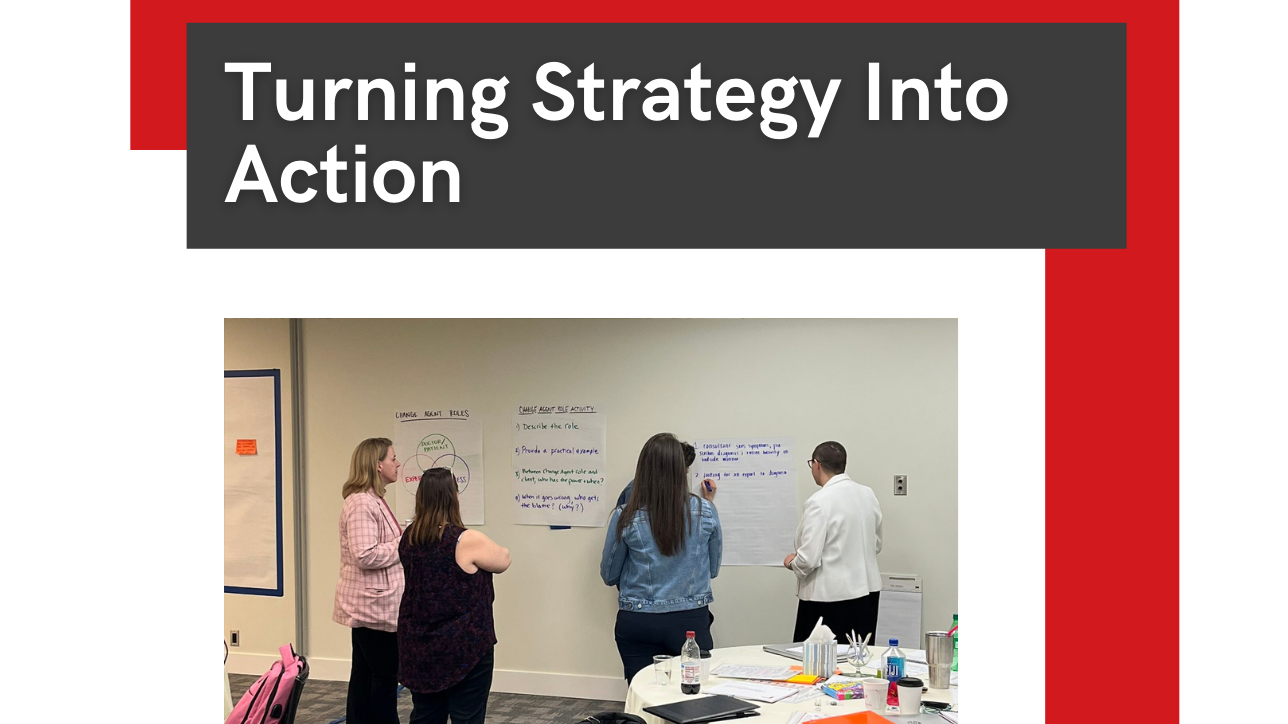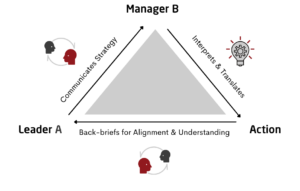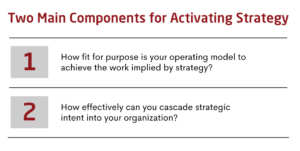5 Min. Read
Takeaway: For effective strategy activation, there are a few points to consider to ensure a successful strategy implementation. Two of the main ones are: “Is my organization configured to achieve our new strategy?” and “Are the right vertical management mechanisms in place to enable strategy to cascade into the entire organization?” Without either of the two, it’ll be significantly more difficult to take strategy off paper.
 “What do you want me to do?” This simple question summarizes the need to discuss enablers of strategy activation.
“What do you want me to do?” This simple question summarizes the need to discuss enablers of strategy activation.
It is a familiar experience for an organization’s leaders to agree on a new competitive strategy and then turn attention to activating strategy. The primary question to ask is, “Is the existing operating model fit for the purpose of delivering the revised strategy?” A related question to ask is, “Have I prepared my organization to turn strategy into action?
Strategy is generally articulated as a direction or intention. It must be translated at operational levels and then set in motion – “What must I do to align to this strategy from my location in the organization?” The configuration and features of your operating model will help or hinder activation. Start your thinking here to increase the probability that your strategic intent translates into effective activation.
Is My Structure a Good Fit?
Strategy is interpreted and activated within the lines and branches of structure. Structure includes the distribution of work and resources, focus and knowledge, and decision-making power. Existing structure, configured for previous strategy, may not be suitable to the new strategy. When this is the case, and structure does not promote the tasks and decision making required in the strategy, then there is a conflict. Structure will inhibit strategy.
An easily understood but extreme example is found in M&A. Two organizations sell complementary products into a single market but generate customer value very differently. Company X is structured to create value through an operational excellence strategy. It acquires Company Y. Company Y is structured to create value through a customer intimacy strategy. Each structure is configured to deliver a different strategy. When the leadership of Company X tries to merge Company Y into its model, they find conflict. Company Y was never configured to deliver operational excellence strategy.
The message is that structure is not substitutable across different strategies. Leadership must assess the quality of fit between the work/behavior created by existing structure and the requirements of new strategy. If the fit is good, then strategy interpretation and activation can flow through existing structure. If the fit is not good, then adjustments or temporary structural mechanisms are required.
How Will I Align the Organization?
Vertical management mechanisms keep the organization aligned top to bottom and directed toward strategy. It is common to hear the phrase “strategy cascade” to refer to the flow of strategy downward through structure. This flow often communicates strategy but misses the value-adding opportunity to help translate strategy into action.
Strategy cascade is a very learnable skill. Most leaders have no agreed guidance or structure.
The process of cascading strategy into an organization is called strategic briefing and back-briefing. It’s borrowed from military practice. The logic is compelling and simple. Leader A communicates strategy to Manager B. Manager B interprets strategy and translates it into proposed action. Manager B then back-briefs Leader A to ensure understanding and alignment. Once confirmed, Manager B carries on with activity.
The collective result of clear strategy communication and an effective cascade process is an organization that translates strategic direction into aligned action in a local context. On the surface it may appear cumbersome, but the practice reconciles alignment, autonomy, and cooperation.
Are the Right People Leading the Change?
The behavioral characteristics of the people in your organization have a strong impact on strategy activation. Unless leaders want to tell their hierarchical subordinates what to do in granular detail, the operating model must promote initiative and responsibility along with effective leadership behavior. How an organization finds and develops these qualities is embedded in the choices it makes about how to recruit, onboard, develop, and retain talent.
Features of people process and rewards/recognition are critical enablers in an operating model capable of agility and rapid strategy deployment. This positions HR as a key player in strategy deployment.
Activating Strategy and the Agile Organization
Activating strategy has two main components: how fit for purpose is your operating model to achieve the work implied by strategy; and, how effectively can you cascade strategic intent into your organization? With rather close-in strategic directives with no operating model implications and relatively undeveloped vertical management mechanisms, you can still drive strategy through familiar mechanisms such as conversation and personal commitment.
However, if you must drive more significant strategic change and maybe develop more sophisticated capability to deploy strategy, you must develop your operating model. If you elect to redesign your operating model you may want to set rapid strategy deployment and activation as a key design criterion. This will set in motion decisions that will configure your operating model for this outcome and create what some call an agile organization. The result will be adaptability and capacity for rapid strategy activation.
Source note: Bungay, S. (2011). The Art of Action: How Leaders Close the Gaps between Plans, Actions, and Results. Nicholas Brealey Publishing.
Never miss out on OTM blog updates.
Subscribe to be notified whenever we post.
Dan Schmitz is a Consultant at ON THE MARK. OTM’s experience and passion for collaborative business transformation that’s supported by pragmatism, systems thinking, and a belief in people is unparalleled. OTM is the leading global boutique organization design consultancy with offices in the USA and UK. With over 450 successful redesigns and operating model modernizations completed, OTM is the owner of the industry’s most integrated, comprehensive, and holistic organization design solution. OTM enables its clients to realize their future ambitions.








